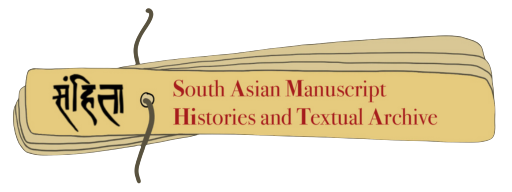Manuscripts
Search Filter
Saddharmapuṇḍarīka
ark:/12148/btv1b10082225n Language : Sanskrit Scripts : Devanagari
This is a Buddhist manuscript . The Mahayana (Lotus Sutra) Saddharmapuṇḍarīka explains why the everlasting Tathagata makes a show of taking birth and dying in this illusory world.The earliest known Sanskrit title for the sūtra is the Saddharma Puṇḍarīka Sūtra, which can be translated as "the Scripture of the Lotus Blossom of the Fine Dharma"Two central teachings of the Lotus Sūtra have been very influential for Mahāyāna Buddhism. The first is the doctrine of the One Vehicle, which says that all Buddhist paths and practices lead to Buddhahood and so they are all merely "skillful means" of reaching Buddhahood. The second is the idea that the lifespan of the Buddha is immeasurable and that therefore, he did not really pass on into final Nirvana (he only appeared to do so as upāya), but is still active teaching the Dharma.
Mahākāla-tantra.
ark:/12148/btv1b100822871 Language : Sanskrit Scripts : Devanagari
Mahākāla is a deity common to Hinduism and Tantric Buddhism In Buddhism, Mahākāla is regarded as the sacred Dharmapāla ("Protector of the Dharma"), while in Hinduism, Mahākāla is a fierce manifestation of the Hindu god Shiva and the consort of the goddess Mahākālī. This manuscript describes Tantra.
Aitareya brāhmaṇa.
ark:/12148/btv1b10083051p Language : Sanskrit Scripts : Devanagari
The Aitareya Brahmana is the Brahmana of the Shakala Shakha of the Rigveda, an ancient Indian collection of sacred hymns. This work, according to the tradition, is ascribed to Mahidasa Aitareya. It is divided into eight pañchikā. And each of the pañchikā devided into Adhyāya. In this manusript five pañchikā and twenty fifth Adhyaya. The first six pañchikā dealing with soma sacrifies nd last two pañchikā desribes rajyabhisheka.
Hevajra-tantra
ark:/12148/btv1b10082446p Language : Sanskrit Scripts : Devanagari
Hevajra is one of the main yidams (enlightened beings) in Tantric, or Vajrayana Buddhism.Hevajra's consort is Nairātmyā. This is tantric text . From Vajrayāna busshism part.
Mahāmantrānusāriṇī.
ark:/12148/btv1b10082962m Language : Sanskrit Scripts : Devanagari
This manuscript is on deity . This is a worshiping and protection Pañcākṣara mantra .
Svayaṃbhū-purāṇa
ark:/12148/btv1b10082349n Language : Sanskrit Scripts : Devanagari
Svayambhū Purāṇa is a Buddhist scripture about the origin and development of Kathmandu valley. Swayambhu Purana gives details of all the Buddhas who came to Kathmandu. It also provides information about the first and the second Buddhas in Buddhism. In this manusript describes Tirthyātrā , some
Devīmāhātmya.
ark:/12148/btv1b100831351 Language : Sanskrit Scripts : Devanagari
The Devi Bhagavata Purana , devī bhāgavatapurāṇa, also known as the Srimad Devi Bhagavatam, Srimad Bhagavatam, Bhagavata Purana or simply Devi Bhagavatam, is one of the eighteen Mahapuranas of Hinduism.Composed in Sanskrit by Veda Vyasa, the text is considered as a major purana for Devi worshippers. It promotes bhakti (devotion) towards Mahadevi, integrating themes from the Shaktadvaitavada tradition (syncretism of Samkhya and Advaita Vedanta. literally, the path of nondualistic Shakti).
Brahmapurāṇa
ark:/12148/btv1b10082800v Language : Sanskrit Scripts : Bengali
The Brahmanda Purana is a Sanskrit text and one of the eighteen major Puranas, a genre of Hindu texts. It is listed as the eighteenth Maha-Purana in almost all the anthologies. The text is also referred in medieval Indian literature as the Vayaviya Purana or Vayaviya Brahmanda.The Brahmanda Purana is one of the oldest Purana.The text is encyclopedic. It is non-sectarian and reveres all gods and goddesses, including Brahma, Vishnu, Shiva, Ganesha, Surya and Shakti.The text's philosophy is a blend of the Vedanta, Samkhya and Yoga schools of Hindu Philosophy, woven in with Bhakti and some tantra themes.
Nyāyakusumāñjali, text and commentary
ark:/12148/btv1b52513232k Language : Sanskrit Scripts : Bengali
Nyayakusumanjali is a famous text of Indian judicial philosophy , authored by Udayanacharya . In this, very strong arguments have been given in favor of theism.The work has been described as codification of the Hindu arguments for the existence of God. It has been noted that this treatise is the most elaborate and the most fundamental work of the Nyaya-Vaiseshika school on the Isvara doctrine.This text is with Commentary.
Sundarakāṇḍa.
ark:/12148/btv1b100827315 Language : Sanskrit Scripts : Bengali
Sundara Kāṇḍa, is the fifth Kāṇḍa of seven. Sundara Kanda is the only chapter of the Ramayana in which the principal protagonist is not Rama, but Hanuman. The work depicts the adventures of Hanuman and his selflessness, strength, and devotion to Rama are emphasised in the text. Hanuman is believed to have been fondly called “Sundara” by his mother Anjana, and Sage Valmiki is stated to have chosen this name over others as the Sundara Kanda is about Hanuman's journey to Lanka.
Vārāhīkalpa-tantra
ark:/12148/btv1b10082464m Language : Sanskrit Scripts : Devanagari
Varahi is a ratri devata (night goddess) and is sometimes called Dhruma Varahi ("dark Varahi") and Dhumavati ("goddess of darkness"). According to Tantra, Varahi should be worshipped after sunset and before sunrise. Parsurama Kalpasutra explicitly states that the time of worship is the middle of the night. Vārāhī is one of the Matrikas, a group of seven mother goddesses in the Hindu religion. Bearing the head of a sow, Varahi is the shakti (feminine energy) of Varaha, the boar avatar of the god Vishnu. In Nepal, she is called Barahi.
Nighaṇṭu.
ark:/12148/btv1b10083175p Language : Sanskrit Scripts : Devanagari
Nighaṇṭu is a Sanskrit term for a traditional collection of words, grouped into thematic categories, often with brief annotations. Such collections share characteristics with glossaries and thesauri, but are not true lexicons, such as the kośa of Sanskrit literature.According to Yaska the Nighantu was a collection of rare or difficult words gathered by earlier sages for easier understanding of Vedic texts that perhaps they may not have fully understood themselves. The collection comprises five adhyāyas or chapters, in three kāṇḍas. naighaṇṭuka kāṇḍa,naigama kāṇḍa,daivata kāṇḍa.













